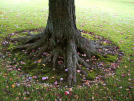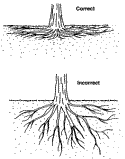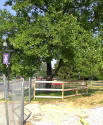|
When
a large, established tree starts looking sick and begins to
decline, the cause is often hidden from view. Although we see
the symptoms in the branches and leaves of the tree, the real
problem is often in the root zone.
 Most people think that the root zone of a tree forms a mirror
image of the canopy. If the tree is 40 feet tall, a thick
"tap" root must go 40 feet down into the ground. Also, it is
common belief that roots only extend away from the trunk to
the "drip line" formed by the overhang of the tree's canopy.
Wrong on both counts! Most people think that the root zone of a tree forms a mirror
image of the canopy. If the tree is 40 feet tall, a thick
"tap" root must go 40 feet down into the ground. Also, it is
common belief that roots only extend away from the trunk to
the "drip line" formed by the overhang of the tree's canopy.
Wrong on both counts!
The
roots of plants have two major functions. One is to provide an
anchor for the plant so that it does not fall over in the
wind. This is accomplished by deep roots and may be the
primary reason that some plants form a tap root. The other
reason that plants need roots is to absorb water and
nutrients. Tiny root hairs do most of this job.
If you think of roots in terms of these two
functions, it explains why the vast majority of a tree’s roots
are actually located in the top 12 to 24 inches of soil. That
is where the water and nutrients are to be found.
 A few thick roots may run deep into the
ground for anchorage but these are a minor part of the overall
root system mass. Not all trees have a true tap root. Some
plants such as the nut trees,
sassafras and some oaks do and
this makes them more difficult to transplant successfully. A few thick roots may run deep into the
ground for anchorage but these are a minor part of the overall
root system mass. Not all trees have a true tap root. Some
plants such as the nut trees,
sassafras and some oaks do and
this makes them more difficult to transplant successfully.
Also, the horizontal range of roots varies
widely from species to species. Some trees send their roots
out to a distance roughly twice their height. A 100 foot tall
tree may have roots out to over 200 feet away from the trunk.
Other trees may only reach out to about half to two thirds
their height. A 60 foot tall spruce may send roots to only 30
or 40 feet away from the trunk.
 Understanding the range and form of a tree's
root system can be very helpful in maintaining tree health.
The root system of a tree must be in "balance" with its
canopy. A certain number of roots are needed to provide water
for a certain number of branches and leaves. Damage to the
root system will result in a corresponding loss of leaves,
branches or, in severe cases, the entire tree may die. Understanding the range and form of a tree's
root system can be very helpful in maintaining tree health.
The root system of a tree must be in "balance" with its
canopy. A certain number of roots are needed to provide water
for a certain number of branches and leaves. Damage to the
root system will result in a corresponding loss of leaves,
branches or, in severe cases, the entire tree may die.
 Roots
may be damaged in many ways. They may be physically damaged
during construction such as digging for sewer lines or they
may be crushed when heavy equipment runs over them. Roots may
be damaged by chemicals such water softener backwash, swimming
pool chlorine or certain herbicides used on the ground above
the root zone. Misused
fertilizers may also cause damage. Roots
may be damaged in many ways. They may be physically damaged
during construction such as digging for sewer lines or they
may be crushed when heavy equipment runs over them. Roots may
be damaged by chemicals such water softener backwash, swimming
pool chlorine or certain herbicides used on the ground above
the root zone. Misused
fertilizers may also cause damage.
Roots may also be damaged in less dramatic
ways. To be healthy, roots need free oxygen in order to grow
and to be able to absorb water from the soil. Thirty years of
foot traffic and rain pounding on the soil around a tree’s
roots may cause soil compaction which squeezes all the oxygen
out. Planting a tree too close to houses, sidewalks, driveways
or other obstructions will limit the expansion of the root
zone needed to support a mature size tree.
|



